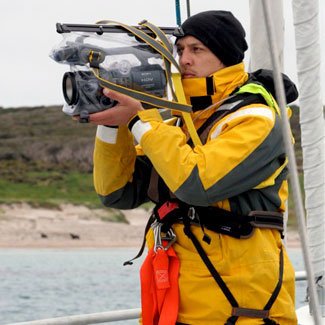Filming in the field with Clark Carter

Photography preparation
Plan ahead: Make a list of the various shots you think you might need. These may include shots of the environment you’re in, animals, yourself (or the subject of your film), video diaries, exciting moments, interviews with other people and shots of everyday life. Just think anything that is important to the project is important to your film.
Check your gear: Is your camera in the right format? Are the batteries charged? Have you got enough tapes/memory cards? Will you need a tripod?
How to photograph well
Steady camera: The best thing to use is of course a tripod, but sometimes it just isn’t an option. If you absolutely have to shoot hand-held, hold the camera steadily against your body or something supportive.This will minimize the amount of shake in your shots.
Get a variety of shots: Try to get a couple of angles and zoom levels of each scene you shoot. For example, if filming someone walking down the street, you may want to get a wide shot of the whole scene, then a few shots of the feet, a close up of the face, a mid shot of their hands swaying back and forth and maybe some of the surrounding area for context.
Video diaries: These are very important as they explain everything that you couldn’t film that day and also your thoughts on the things that you did film. For instance, you may want to talk to the camera about how you’re feeling about the project as a whole so far, your worries, your hopes, and anything of interest that has happened. The aim of these is to let the viewer know what’s going on inside your head and to explain some of the shots you may have taken that day. Try to do a video diary once a day.
Ten second rule: Always record for at least ten seconds, minimum! This may feel like a long time when you’re filming, but makes life a lot easier when editing the footage. Try getting into the habit of using five-second ‘handles’ at the beginning and end, each time you press record. This means you minimize the chance of cutting your shot to early, thus making it useless in the editing room. If you’re having trouble, count it out loud.
What to avoid
Filming into the sun: Avoid shooting your subject with the sun in the background — this will make everything silhouetted and dark. It is much better to film with the sun on your back, so it lights your subject. Just remember to keep your shadow out of the shot. However, if you decide you want a silhouette shot, then by all means shoot into the sun!
Excessive zooming: Zooming in and out during a scene can be distracting and look amateur. If you have to zoom, try filming at one zoom level for ten seconds, then zoom in and shoot at that second zoom level for another ten seconds. Steady and controlled filming is the key. The exception is if something unexpected happens and you need to zoom rapidly to catch what’s happening quickly.
Wind: If you’re filming someone talking and there is a bit of wind around, chances are the camera’s microphone will be useless and your shot wasted. This is not so important if you’re simply after the image, rather than sound. Try using a windsock for your microphone, or filming from a sheltered area out of the wind. Even filming with your back to the wind can help. Keep in mind that sometimes wind blasting into the microphone can enhance your shot, if you want to show how horrible the weather is.
Read about Clark’s Victoria Crossing expedition in Chills and thrills

